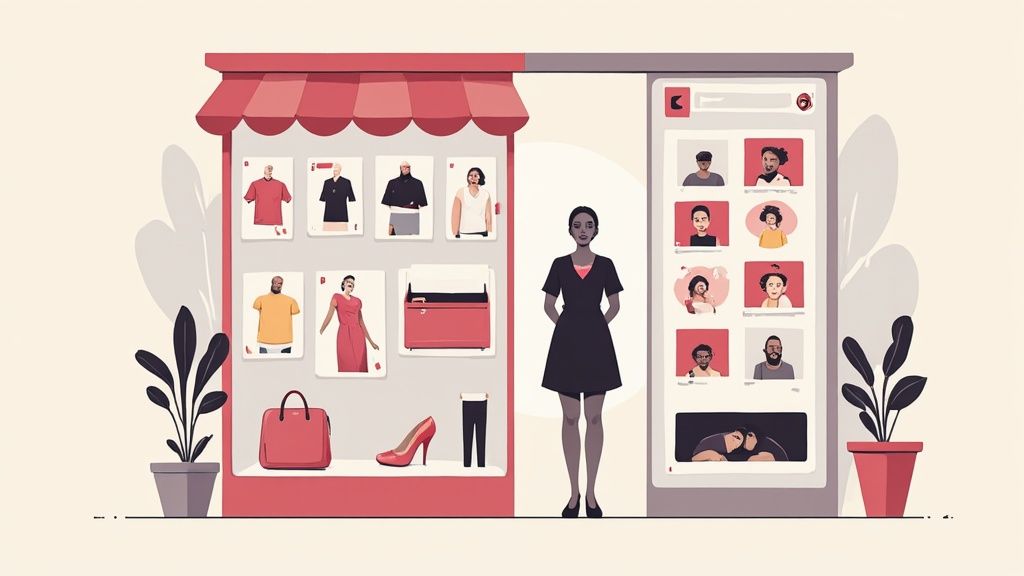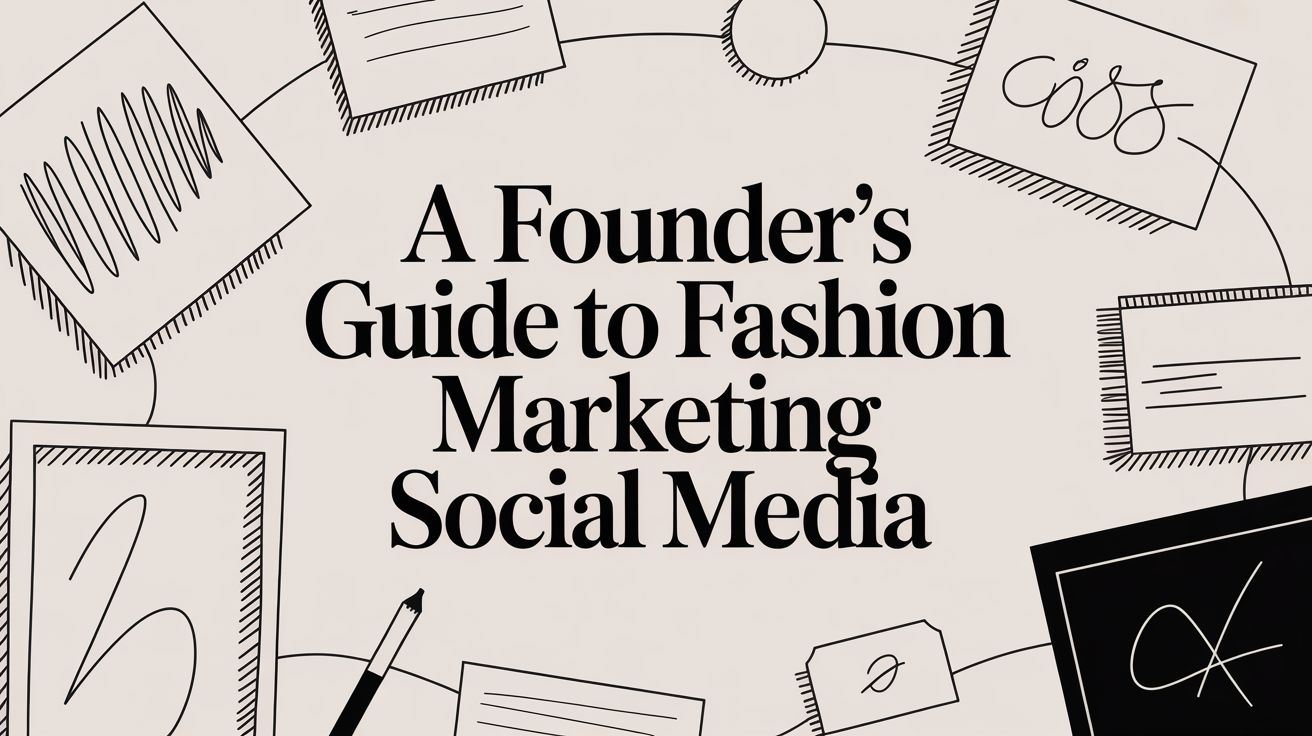Let's cut the fluff. Social media isn't a gallery for pretty pictures. It's the growth engine for your fashion brand. We've been in the trenches. We know what actually moves the needle. This is a founder-to-founder playbook for building a fashion marketing social media strategy that sells.
Your No-Nonsense Social Media Playbook
This guide is built on real experience. It helps you stop guessing and start executing. Social media is your most direct line to customers. Breaking through the noise requires a plan, not just random posts.
The goal isn't just likes. It's building a brand people connect with and buy from. Today, 73% of marketers say social media efforts have been "somewhat effective" or "very effective" for their business. For fashion, it’s your digital runway, lookbook, and community hub rolled into one.
Here’s what this guide will show you:
Focus on the platforms that matter for fashion.
Create content that turns browsers into buyers.
Measure what counts without drowning in data.
Why a Playbook Matters
Without a real strategy, you're throwing content at a wall. You'll burn cash on posts that look great but don't sell. A playbook gives you structure to make smart, repeatable decisions that lead to growth.
"Social media allows big companies to act small again." - Jay Baer, Marketing Expert
This is especially true for DTC fashion brands. You talk directly to your customers. You get instant feedback. You build a community. That’s your advantage against slow-moving legacy brands.
We'll cover the essential platforms and the creative that works. For a deeper dive into making videos people share, check out these fashion viral video marketing strategies.
Think of this as your roadmap to moving product.
Choosing Your Platforms: Instagram and TikTok

You can’t be everywhere at once. Spreading your brand thin is the fastest way to burn your budget. For fashion, the game is won on two fields: Instagram and TikTok.
Trying to master Facebook, Pinterest, and X right away is a mistake. Focus your time and ad dollars where customers actually are. This isn't about ignoring other channels forever. It's about winning the most important battles first.
Instagram and TikTok are non-negotiable for fashion brands. But they demand different playbooks. Get both right, and you'll build an engine that drives discovery and sales.
Instagram: Your Digital Storefront
Think of Instagram as your brand’s shoppable home base. It's your polished lookbook. It's your digital storefront. The aesthetic you build here defines your brand in three seconds.
Your feed is where you put your best foot forward. High-quality, curated content that tells a consistent story. This is for stunning product shots and slick campaign photos. Stories are for the raw, behind-the-scenes stuff that builds a real connection.
Let's be clear: Instagram runs fashion. A 2024 survey showed a whopping 79% of marketers globally use Instagram for advertising. It's the most popular niche, with 35.8 million fashion-related posts this year alone. These influencer marketing statistics paint the full picture. Your customers are here, looking for their next purchase.
TikTok: Your Culture Engine
If Instagram is your curated storefront, TikTok is your culture engine. This is not the place for glossy campaign videos. Success here is about raw, authentic content that plugs into trends.
TikTok is where your brand’s personality comes out. It's for lo-fi try-on hauls and behind-the-scenes chaos. It's for useful styling tips. The algorithm rewards content that feels like it belongs there—real, unpolished, and entertaining. The goal isn’t a direct sale from every video. It’s about discovery.
"On TikTok, don't make ads. Make TikToks." - TikTok For Business
This distinction is everything. Pushing the same creative on both platforms is a common, costly mistake. What works on Instagram feels corporate on TikTok. What pops on TikTok can look messy on your IG feed. Each platform has a specific job. If you need help scaling ads here, our guide on the best TikTok ads agencies for DTC brands is a good start.
Platform Strategy: Instagram vs. TikTok
You need a clear framework. Define the purpose for each channel. Allocate your resources with intention.
Here’s a simple table to help you think:
This breakdown clarifies where to focus your energy. Use Instagram to close the deal. Use TikTok to introduce your brand to new fans.
When they work together, they create a seamless customer journey.
The Creative That Actually Sells

Your creative makes or breaks your brand on social. Generic lifestyle shots and sterile product photos are wallpaper. People scroll right past them.
To stop the scroll, you need creative that feels real. This means a smart mix. Polished assets build your brand’s aesthetic. Lo-fi, user-generated content builds trust. One creates desire, the other smashes doubt.
The goal is a system that churns out effective creative. It should fuel your organic posts and paid ads without torching your budget.
Writing Briefs That Work
Great creative starts with a great brief. Most briefs are too vague or too restrictive. You need to give creators clear guardrails, not a step-by-step manual.
A winning brief gives creators enough direction to stay on-brand. But it gives them enough freedom to make something that feels native to their style.
Here’s what a solid brief should cover:
The Big Idea: The core message in one sentence. Is it about soft fabric? A new color? A specific way to style a piece?
The Vibe: Three to five words that capture the mood. "Effortless, sunny, confident."
Key Talking Points: Bullet points for must-haves. Mention sustainable materials or wrinkle-free fabric, but let the creator use their own voice.
The Hard No's: Be clear about what to avoid. No competitor logos. No awkward phrases.
This structure respects the creator's process. It gets you content that hits your goals without feeling like a forced ad.
The Content That Moves Product
Certain content types just work for fashion. They show the product in the wild. They answer customer questions before they're asked.
The best creative doesn't just show what your product is. It shows what your product does for the customer. It shows value, fit, and feeling.
Short-form video has changed the game. Fashion creators on TikTok see an average engagement rate of 2.26%, far above other platforms. Video makes fashion tangible. In fact, a staggering 80% of Snapchatters now use social media for style inspiration, turning apps into digital storefronts.
Here are the video formats you need:
Try-On Hauls: Simple and effective. Showing products on different body types helps customers visualize the fit.
Styling Tips: Show three ways to wear one piece. This provides value and helps justify the purchase.
Behind-the-Scenes: A quick look at your design process. This builds a human connection.
UGC-Style Problem/Solution: "My old jeans never fit right... then I found these." This format positions your product as the solution.
For a full breakdown, check our guide on types of content on social media. To generate visuals at scale, explore AI product photography techniques.
When you build a library of these assets, you build a powerful toolkit. You can chop up a video into a Reel, a carousel, and a paid ad. This is how you build a content engine that drives results.
Paid vs. Organic: Finding the Right Mix

Let’s be honest. Building organic reach is a slow grind. But blindly throwing money at ads is a fast way to burn cash.
The magic isn’t choosing sides. It’s building a loop where your organic and paid efforts feed each other.
Think of it this way: organic content is your brand’s personality. It’s the styling tips and UGC that builds community. It proves you’re more than a product catalog.
Paid ads are the megaphone. They take content that’s already hitting a nerve and blast it to new customers.
When these two work together, you create momentum. Your best Reel becomes your next winning ad. Customers from that ad follow you. They create their own UGC. The cycle starts again.
The Organic-to-Paid Flywheel
This isn't a complex theory. It’s a simple system. You use organic channels as a free testing ground. When a post blows up, you put ad dollars behind it.
Here’s how it works:
Post Consistently: Share a healthy mix of content on Instagram and TikTok.
Find Your Winners: Wait a week, then check your analytics. Which posts got the most saves, shares, and comments?
Amplify with Ads: Take that top post and turn it into a paid campaign. Use the exact creative that already proved it can stop the scroll.
This de-risks your ad spend. Instead of guessing what will resonate, you're betting on a sure thing.
A Smarter Budget Split
So, how much should you spend? A common mistake is splitting the budget 50/50 between brand awareness and conversion ads. For a young brand, this is lighting cash on fire.
Allocate your budget based on audience "temperature."
Forget the 50/50 split. Start with a 70/20/10 model: Pour 70% of your budget into retargeting warm audiences (site visitors, cart abandoners), 20% into lookalike audiences, and only 10% into broad, cold prospecting.
This model focuses on converting low-hanging fruit first. That generates revenue you can reinvest later. As you grow, you can shift these percentages.
Managing this workflow is a massive time sink. Our guide on freelancers vs. agencies for scaling paid social campaigns breaks down the pros and cons to help you decide on help.
By creating this tight feedback loop, you build a sustainable growth machine. You stop guessing and start making data-backed moves.
Working with Influencers Who Drive Sales
Effective influencer marketing isn't about paying a celebrity for one post. That's just renting an audience. Real results come from building authentic partnerships that build trust and drive sales.
This is about creating a scalable program. Forget the big names for a minute. Your most powerful allies are micro-influencers. They have smaller, deeply engaged communities who trust their recommendations.
The game is finding creators whose audience mirrors your ideal customer. When they feature your product, it lands like a tip from a friend, not another ad.
Finding and Vetting Partners
Finding the right influencers can be a grind. Start by digging into the hashtags your actual customers use. Your sweet spot is usually creators in the 5k-50k follower range.
The comments section is your truth serum. Is it filled with spam or real conversations? An active community is the clearest sign of real influence.
Before you reach out, do your homework:
Audience Demographics: Do their followers match your customer profile? Ask for a media kit to verify.
Brand Alignment: Does their vibe and aesthetic line up with yours?
Past Partnerships: Scroll through their previous sponsored posts. Does it feel natural, or are they just a walking billboard?
Structuring Deals and Writing Briefs
Once you find a potential partner, structure a deal that works for both of you.
Here are a few ways to structure a partnership:
Gifting: Perfect for new brands. You send free products in exchange for content, with no strict posting requirements.
Commission: Affiliate links are your best friend. You give the creator a percentage of every sale they drive. They only make money when you do.
Flat Fee: Reserve this for specific campaigns where you need guaranteed posts. This works best with creators you already have a relationship with.
The brief you send is everything. It's a guardrail, not a cage. Give creators a clear mission, then the freedom to execute it in their own voice. A brief that’s too prescriptive kills the authenticity.
Your brief should have one key message. Add a few talking points (in bullets). List any "don'ts." That's it. Trust the creator.
Maximizing Your Investment
The biggest mistake brands make is letting influencer content die on their feed. Repurpose that content across all your channels. That one Reel can become your next hero ad.
The data backs this up. Globally, 86% of consumers buy something inspired by an influencer each year. Nearly half of all regular purchases are influenced by creator content. To get the full picture, you can read the complete research on the fashion influencer market.
When you repurpose influencer content in your paid ads, you get authentic, high-performing creative without massive production costs. It's the ultimate social proof. Seeing a real person they trust use your product shatters purchase anxiety.
Measuring Success and Planning Your Next Move
If you can’t measure it, you can’t improve it. It's easy to get lost in vanity metrics like follower counts. They feel good, but they don't pay the bills.
You have to focus on what signals real business health. This isn’t about building a complex dashboard. It’s about having a simple view of what’s working so you can double down on your winners.
Key Metrics That Matter
Forget chasing every metric. For a growing fashion brand, only a handful of numbers tell you if your social media is turning into sales.
These are the numbers you should live by:
Customer Acquisition Cost (CAC): Your total marketing cost divided by the number of new customers. This is the first step to building a profitable business.
Return on Ad Spend (ROAS): For every dollar you put into ads, how many dollars do you get back? This is the most direct measure of your paid campaigns.
Engagement Rate: Not just likes. Look at shares, saves, and comments. If a certain video style gets insane engagement, that’s your roadmap for what to make next.
Nailing these three gives you a clear picture of your marketing engine’s health.
Establishing a Simple Reporting Rhythm
The secret to growth is a simple rhythm: launch, learn, iterate. This requires a consistent reporting cadence.
A simple, effective rhythm looks like this:
Weekly Check-in: A quick look at your paid campaigns. Are top ads still performing? Is ROAS steady? This is for small tweaks.
Monthly Review: Go deeper on what worked and flopped, paid and organic. Which content drove engagement? Which influencer drove sales? Decide what to scale or cut.
Quarterly Planning: Zoom out and look at the big picture. How has your CAC trended? Are you getting more efficient? Set your goals and budget for the next quarter.
This rhythm keeps you focused. It stops you from making panicked decisions based on one bad day.
"What gets measured gets managed." - Peter Drucker
This quote is a cliché for a reason. Tracking the right data takes the guesswork out of your strategy. It transforms marketing from an expense into a predictable investment.
Research shows 69% of marketers use social media for brand awareness. But for a founder, awareness is a byproduct of what really matters: driving sales. Obsessing over CAC and ROAS keeps you tied to the bottom line. You can learn how other brands use social media for business goals and steal their ideas.
This disciplined approach ensures every piece of content has a clear purpose.
FAQ: Your Top Questions Answered
We get it. Social media for fashion moves fast. Here are straight answers to the questions we hear most.
How much should a new fashion brand spend on social media ads?
A good starting point is 10-20% of your marketing budget. But don't fixate on a dollar amount. The real question is: what’s my target Customer Acquisition Cost (CAC)?
Start small. A $20-$50 daily budget is enough to test creative and find an audience. Once you find a combo that delivers a profitable Return on Ad Spend (ROAS), then you can scale. Prove the model works before you pour gas on the fire.
What type of content works for fashion brands right now?
Authentic, video-first content is winning.
Think less about glossy photoshoots. Think more about raw stuff: behind-the-scenes, try-on hauls, styling tips, and especially user-generated content (UGC). Customers want to see how your pieces look in the real world, not in a studio.
"People influence people. Nothing influences people more than a recommendation from a trusted friend. A trusted referral influences people more than the best broadcast message." - Mark Zuckerberg, CEO of Meta
Short-form video on TikTok and Reels is non-negotiable for discovery. It feels genuine. It’s what modern shoppers expect. A report found 73% of shoppers say UGC makes them more confident at checkout. You can see more in this breakdown of key influencer marketing statistics.
How do I find the right influencers for my brand?
Look past the follower count. Fake followers won't sell a single t-shirt. The best influencers have an engaged community that matches your ideal customer.
Start by digging into niche hashtags. Look for micro-influencers (5k-50k followers) whose posts are buzzing with real comments. A lively comments section is a clear sign of actual influence.
Do your homework before reaching out. Vet their audience with analytics tools. Most importantly, make sure their personal brand is a genuine match for yours. This isn't about renting an audience. It's about finding a partner.
Running a fashion brand is chaotic enough. Stop trying to juggle a dozen different tools, freelancers, and spreadsheets. Needle acts as your AI-powered marketing agency, handling everything from strategy and creative production to campaign launch and analysis—all for a fraction of what you'd pay a traditional agency. See how it works at https://www.askneedle.com.

